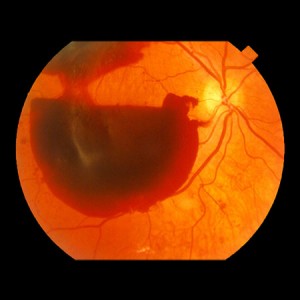Vitreous Hemorrhage
 The vitreous is the gelatinous-like substance that makes up approximately two-thirds of the eye's volume. The vitreous is located in between the lens, in the front of the eye, and the retina, in the back of the eye. There are normally no blood vessels within the vitreous gel. Abnormal blood vessels can grow into the vitreous gel in a variety of eye diseases, most commonly diabetic retinopathy. These blood vessels are often fragile and susceptible to bleeding.
The vitreous is the gelatinous-like substance that makes up approximately two-thirds of the eye's volume. The vitreous is located in between the lens, in the front of the eye, and the retina, in the back of the eye. There are normally no blood vessels within the vitreous gel. Abnormal blood vessels can grow into the vitreous gel in a variety of eye diseases, most commonly diabetic retinopathy. These blood vessels are often fragile and susceptible to bleeding.
Causes of a Vitreous Hemorrhage
A vitreous hemorrhage occurs when a blood vessel ruptures and causes bleeding within the vitreous gel, resulting in visual symptoms. There are various causes of a vitreous hemorrhage, including:
- Diabetic retinopathy
- Retinal vein occlusion
- Ocular ischemic syndrome
- Posterior vitreous detachment
- Retinal detachment
- Sickle cell retinopathy
- Retinopathy of prematurity
- Terson's syndrome
- Retinal macroaneurysms
- Tumor
- Leukemia
- Trauma
- Choroidal neovascularization
Symptoms of a Vitreous Hemorrhage
Patients with vitreous hemorrhage usually notice the following symptoms:
- A sudden, significant increase in the number and size of floaters
- Vision loss
- Blurry, cloudy or hazy vision
- Flashes of light
When symptoms occur, it is important for patients to seek prompt medical attention.
Diagnosis of a Vitreous Hemorrhage
The doctor will examine the patient's eyes as well as review their medical history to determine the cause of the hemorrhage. An appropriate treatment will be recommended. To confirm the diagnosis, a series of diagnostic tests may be performed such as:
- Gonioscopy
- Intraocular Pressure
- Slit-lamp examination
- Dilated eye examination
- B-scan ultrasonography
Treatment of a Vitreous Hemorrhage
If a retinal detachment or break is diagnosed, a vitrectomy is performed immediately. Treatment for a vitreous hemorrhage will be determined based on the underlying cause and chronicity of the condition. Some of the treatments for a vitreous hemorrhage include:
- Observation
- Cryotherapy
- Laser photocoagulation
- Intravitreal injections
- Vitrectomy


